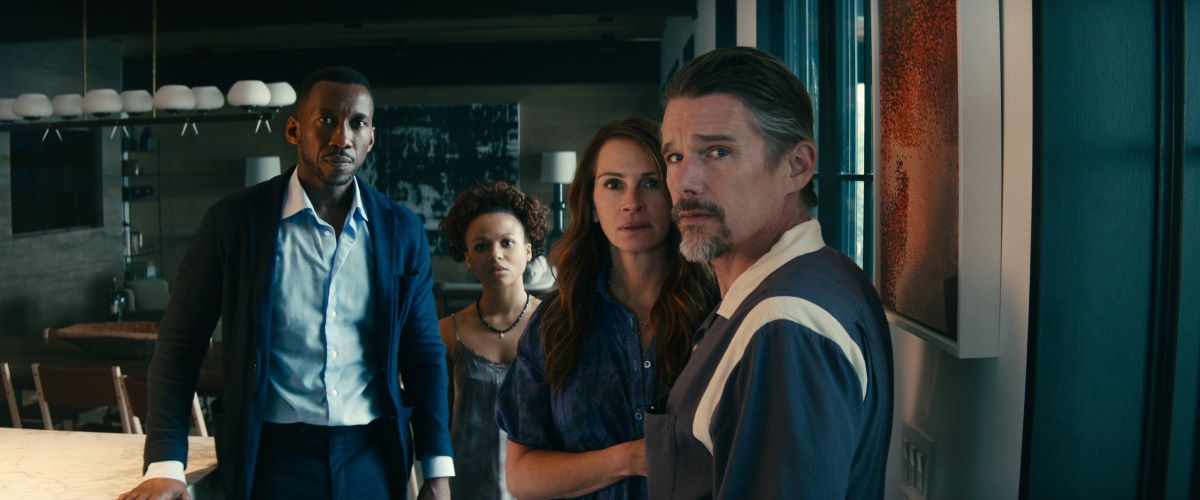“Leave the World Behind,” writer/director and “Mr. Robot” creator Sam Esmail’s suspenseful, psychological thriller, understands the general mechanics of the post-apocalyptic genre. There is the pretentious family caught in world-altering circumstances. “I f*cking hate people,” says Amanda Sandford (Julia Roberts), as she stares jadedly from the window of her luxe Brooklyn apartment. And so Amanda and her amiable husband Clay (Ethan Hawke) take their children Rose (Farrah Mackenzie) and Archie (Charlie Evans) to a lavish Long Island mansion for the weekend. Similar to other disaster flicks, this film worms through oddball characters, takes interest in the disintegration of society, and the tension that arises from disparate people pushed to survive with each other. But “Leave the World Behind” struggles where it matters most, fashioning real stakes to accompany the turmoil.
Post-apocalyptic movies have almost become a holiday tradition for Netflix. “Don’t Look Up,” “White Noise,” “Bird Box” have all arrived in the Thanksgiving to Christmas window in recent years. While “Leave the World Behind,” adapted from the same-titled novel by Rumaan Alam, bears some superficial similarities with McKay and Baumbach’s disaster offerings, you mostly feel Steve De Jarnatt’s “Miracle Mile” in the DNA of Esmail’s film.
Like De Jarnatt’s LA-set romantic-thriller, “Leave the World Behind” is a conspiracy theory come to life. At first, the signs are minute—while on vacation the Sandford lose their cell service—and then grow in magnitude. As they sunbathe on a beach, a wayward cargo ship crashes on the shore. By nightfall, they hear a mysterious knock at their door. The home’s owner G.H. Scott (a charming Mahershala Ali) and his daughter Ruth (Myha’la) have suddenly returned due to a city-wide blackout afflicting New York. A bigoted Amanda is suspicious that these people are the actual owners. She also doesn’t believe there’s a blackout, even though, apart from a national emergency advisement, the televisions in the house have stopped working. Meanwhile, G.H. is shook for a different reason: The events are beginning to align with a proposed government plan that would feel outlandish if not for the reality of the situation.
The racial tension between the Sandfords and the Scotts fuels much of the disaster flick. This might be the most despicable Roberts has been on screen: She is vicious and self-centered, elevating the feelings and desires of her white children above the emotions felt by Ruth, whose mother is missing. The film stops just short of truly calling Amanda racist, creating instead a lame backstory to excuse her pettiness. It also stops short of sketching out a personality for Amanda’s son and mostly relies on a one-note, albeit funny joke regarding “Friends” to grant Amanda’s daughter an identity. These basic building blocks, in the hands of capable actors, are enough to instill a sense of dread over much of the proceedings.
The same can be said of Esmail’s love of wild, swinging camera movement. Mileage will vary for many as he and cinematographer Tod Campbell do long pans, ostentatious crane shots, and reoriented compositions to illustrate the topsy-turvy calamities: powerless planes and paper fliers falling from the sky, dead bodies washing up on the beach, and weaponized self-driving Teslas. Even Kevin Bacon appears as a mysterious off-the-grid figure. With so many contemporary films relying on a staid visual language, it’s actually quite wonderful to see a couple of creatives having fun shooting an already absurd premise.
There is, however, a larger issue with “Leave the World Behind.” It relies on an idle desire to be a machine for tension. What are the stakes and how are they actualized? To fully interrogate the film’s failing requires spoiling it. So please, if you wish to go in blind—which I would recommend—read no further.
Alright, here we go: The greatest weapon a disaster film has is the onscreen death. Deployed correctly, for the right character, it can bring the grander emotional impact of the world ending onto a personal level. Sometimes it’s a side character, usually the best friend of the protagonist (“Volcano” or “Daylight”), a patriarch or matriarch (“Dante’s Peak,” “The Poseidon Adventure,” or “Twister”), and if you really want to go for broke, the hero (“Armageddon” or “Miracle Mile”). But generally, in a good disaster film, you need a good death that affects the protagonist in such a way that it pushes them toward survival, toward empathy, toward humanity. “Leave the World Behind” lacks such a moment. So as the narrative moves through its chapter structure, stretching for 141 minutes, the storytelling becomes lax and wobbly.
While “Leave the World Behind” is absorbing, particularly in its character-driven motifs and actorly prowess, it remains distant, emotionally withholding a human element, as though it were a top-secret clue rather than a necessary key to the heart.
In limited release now. On Netflix on December 8th.




















